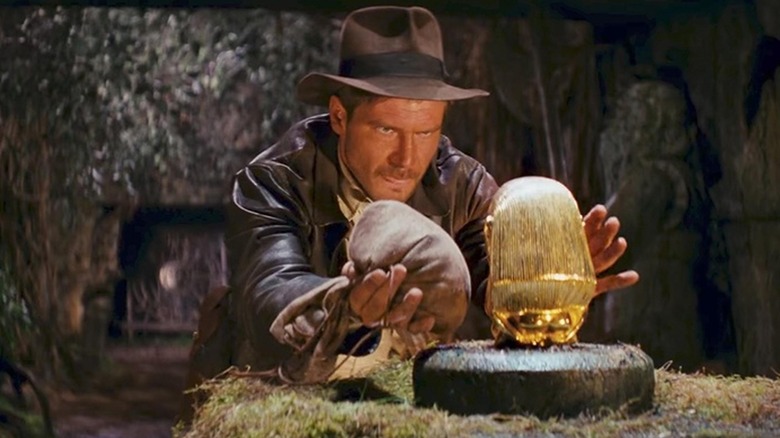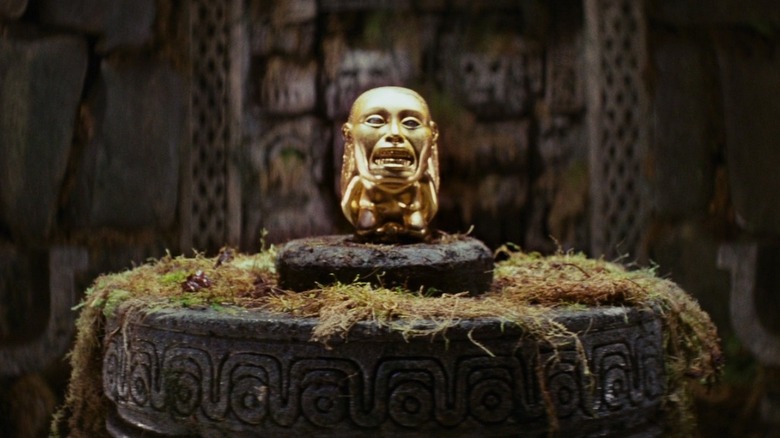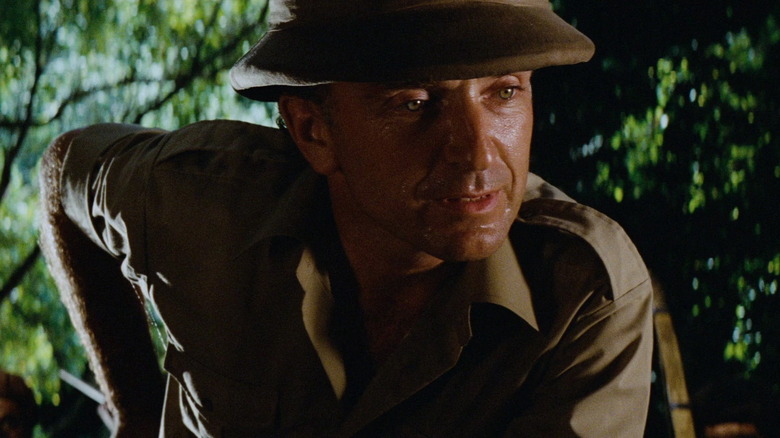Indiana Jones' Golden Idol Was Really Just A Cheap Souvenir
Steven Spielberg's 1981 adventure film "Raiders of the Lost Ark" opens in "South America" in 1936, actually Peru. The Peruvian jungle sequences were shot in Hawaii, while the stone temples were constructed on a soundstage at Elstree Studios in England. The film's famed opening sequence sees Professor Henry "Indiana" Jones (Harrison Ford) trekking into said Peruvian temple — a temple lousy with spiders and booby traps — to retrieve a golden Idol left standing on a stone alter in a long-hidden antechamber. This near-mythic object was clearly well-protected by the long-dead tribes that put it there, as still-functioning traps fired spears or darts into any potential interlopers. Once Indy retrieves the idol, it is promptly stolen by a rival archaeologist named Belloq (Paul Freeman).
The idol doesn't play a role in "Raiders of the Lost Ark" beyond that opening sequence, and the film never stops to explain exactly what it is or what historical function it served. The idol is merely an object to be carefully acquired and viciously fought over; we know it's important enough to die for.
It seems that the idol itself, while based on actual Peruvian fertility totems, was merely built by production designer Norman Reynolds. He had purchased a similar idol from a souvenir stand while traveling and built a gussied-up version made to look like it was made of gold. Later, Reynolds was happy to learn that his idol ended up falling into synch with actual early-American artifacts, specifically of the Aztec goddess Tlazolteotl. It would later be discovered, however, that the real-life Tlazolteotl idol that he based it on might have, itself, been a fake.
An authentic piece?
The idol is a sculpture of a woman, squatting and grimacing in pain as she gives birth. A baby can be seen emerging from her body. Reynolds was only concerned, of course, with how the idol might look on screen. The size had to be right, and it had to be gold. In a 2016 interview with the BBC, quoted in a 2021 Time Magazine 40th anniversary special, he said:
"It was a fertility figure that seemed to be a good size for the idol. [...] So I bought it and adapted it and changed it slightly and made sure it worked for the hand. It was black, so I made it gold. It worked, and I was delighted that it was an authentic piece."
And that's how a cheap souvenir became one of the most famous movie props in cinema history.
It was assumed that the idol was authentic for many years, as it resembled an artifact held at the Dumbarton Oaks Museum in Washington, DC. The Dumbarton piece was thought to be Aztec in origin, and for many years, it was presented to the public as such. Some recent scans, however, revealed textures and cracks in the surface of the Dumbarton idol that could only have been made by modern drills and electric tools. This has led some scholars to assume that it's a fake, constructed sometime in the mid-19th century.
The idol prop from "Raiders of the Lost Ark," then, was based on a cheap Peruvian souvenir, which was based on a real Aztec artifact, that was actually a fake. The research done on the Dumbarton Tlazolteotl has been extensive, with a lot of postulation as to what it was made of and what goddess it, in fact, represents. It may also be Toci or Ixcuina or some other non-Aztec figure entirely.
Why did Belloq want it?
Ultimately, Indy's trekking into a jungle to retrieve a lost golden treasure has a lot more in common with old pulp novels and Scrooge McDuck comics than with actual archeological authenticity.
Of course, now the question arises: why did Belloq, revealed to be a French free agent in the employ of the Nazi government, want an idol of a Peruvian fertility deity? It turns out this part of the story was depressingly authentic. Given the time period of "Raiders of the Lost Ark," and the presence of Nazis in the story, one can assert that the idol was constructed by the Chachapoya culture, a pre-Incan tribe that lived in Peru from about A.D. 800 until about 1400. It seems that a scientist and racist ethnographer named Jacques de Mahieu, working for the Nazis, once wrote several specious essays and "studies" asserting that the Chachapoyan people were, in fact, descended from Scandinavian Vikings.
If the Chachapoyan people were in fact taken over by, or had something to do with Vikings, that would lend credence to several white supremacist talking points, positing that civilizations could only form with certain races in charge. As such, Hilter was keenly interested in the Chachapoyan research, feeling that the culture's accomplishments could be used to justify his racist homicidal impulses. The fact that a Nazi sympathizer is in the jungles of Peru hoping to claim an artifact has far less to do with an object's monetary value or museum prestige and more to do with Aryan race theory.
Spielberg, a Jewish filmmaker, knew what he was doing. Later in the film, he would use the Ark of the Covenant, a Jewish artifact, to blast Belloq and his fellow Nazis to smithereens. Divine justice is achieved.


